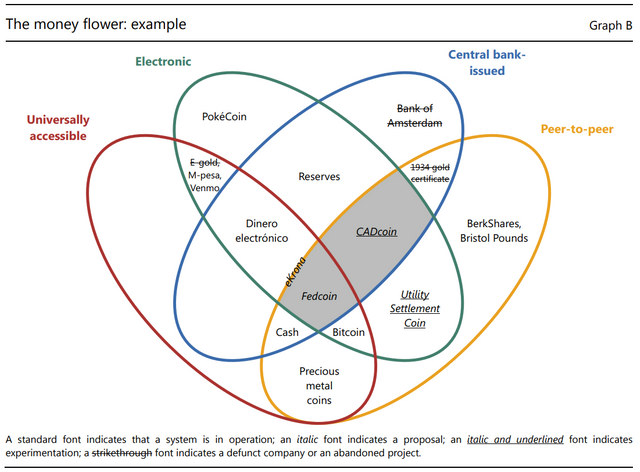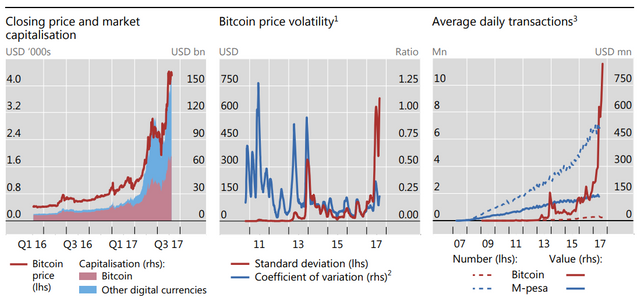
The Central Bank of Central Banks, Switzerland’s Bank for International Settlements (BIS), released a report on Sunday that looks at central bank cryptocurrencies (CBCCs), and if they would they be useful.
The 17-page report, titled “Central Bank Cryptocurrencies,” was co-written by Morten Bech and UC Santa Barbara’s Rodney Garratt.
The report outlines that bitcoin has gone from being an obscure curiosity to a household name in less than a decade. “Its value has risen - with ups and downs - from a few cents per coin to over $4,000,” the authors clarify. “In the meantime, hundreds of other cryptocurrencies - equalling bitcoin in market value - have emerged.”
Central banks have recently entered the fray, with several announcing that they are exploring or experimenting with the underlying technologies. “The prospect of central bank crypto- or digital currencies is attracting considerable attention,” the report states. “But making sense of all this is difficult.”
“New cryptocurrencies are emerging almost daily, and many interested parties are wondering whether central banks should issue their own versions. But what might central bank cryptocurrencies (CBCCs) look like and would they be useful?” - Bank for International Settlements
There is confusion over what these new currencies are and discussions often occur without a common understanding of what is actually being proposed, the authors claim, and they propose a new classification system, or “taxonomy of money.”
The framework seeks to provide some clarity by answering a deceptively simple question: “what are central bank cryptocurrencies (CBCCs)?”
The taxonomy is based on four key properties; issuer, central bank or other; form, electronic or physical; accessibility, universal or limited; and transfer mechanism, centralised or decentralised.
The report states that it reflects “what appears to be emerging in practice,” and distinguishes between two potential types of CBCC, both of which are electronic: central bank-issued and peer-to-peer. One is accessible to the general public (retail CBCC) and the other is available only to financial institutions (wholesale CBCC).

In principle, the authors argue, there are four different kinds of electronic central bank money: two kinds of CBCCs (the shaded area) and two kinds of central bank deposits. The most familiar forms of central bank deposits are those held by commercial banks - often referred to as settlement accounts or reserves.
Universally accessible forms of money that are not issued by the central bank include privately created cryptocurrency, commodity money, commercial bank deposits and mobile money.
“Cryptocurrency borders CBCC given that only one of its properties differs. The other three currency forms are more removed because they are, in addition, either physical or ‘not peer-to-peer’,” the report states. A number of other forms of money are not universally accessible.
Local (physical) currencies, ie currencies that can be spent in a particular geographical location at participating organisations, populate the right-hand petal of the flower. The upper left-hand petal contains virtual currencies, which are "electronic money issued and usually controlled by its developers, and used and accepted among the members of a specific virtual community." There is also the possibility of a private sector wholesale version of cryptocurrency. It would be transferred in a peer-to-peer fashion by means of a distributed ledger, but only between certain financial institutions.

The report states that “it seems unlikely that bitcoin or its sisters will displace sovereign currencies,” and focuses on the technologies that they use. “They have demonstrated the viability of the underlying blockchain or distributed ledger technology (DLT).”
The blockchain version of DLT has successfully powered Bitcoin for several years, the authors qualify, while stating “the system is not without drawbacks.” The Bitcoin proof-of-work blockchain is costly to operate, they state, there is only probabilistic finality of settlement, and all transactions are public, “These features are not suitable for many financial market applications.”
Current wholesale DLT payment applications have therefore “abandoned the standard blockchain technology,” in favour of protocols that modify the consensus process in order to allow enhanced confidentiality and scalability.
Examples of protocols currently being tested by central banks include Corda and Hyperledger Fabric. Corda replaces blockchain with a "notary" architecture. The notary design utilises a trusted authority and allows consensus to be reached on an individual transaction basis, rather than in blocks, with limited information-sharing.
While Bitcoin is described as unsuitable for many financial markets, the report highlights that the value transacted over Bitcoin has this year surpassed the value transacted over M-pesa.
M-Pesa is a mobile phone-based money transfer, financing and microfinancing service, and was previously the largest electronic money system outside of the banking system.

The Bank for International Settlements was established in 1930, by an intergovernmental agreement between many of the world’s most powerful nations, and was originally created to facilitate reparations imposed on Germany after WWI. It has since been given the single goal of “fostering international cooperation” between its member banks.
The BIS is often referred to as the Central Banker’s Central Bank, because it has occasionally acted as a lender to its member banks. Headquartered in Basel, Switzerland, the organization has a membership of 60 central banks, from countries that make up about 95% of world’s GDP.
In November 2015, the BIS made its first statement on cryptocurrencies, that simply tried to explain what they are, and weigh banking and consumer risks prior to regulation. The report simply concluded that “distributed ledger technology will continue to emerge and develop.”
“The emergence of distributed ledger technology could present a hypothetical challenge to central banks, not through replacing a central bank with some other kind of central body but mainly because it reduces the functions of a central body and, in an extreme case, may obviate the need for a central body entirely for certain functions.” - Bank for International Settlements, 2015
A second BIS report was released in February of this year, focusing on the benefits of that very technology. The organization then released a third report titled “Distributed ledger technology in payment, clearing and settlement - an analytical framework.” Intended for its member banks to read, the report offered pros and cons of the technology.
While the vast majority of the 29-page paper talked about how DLT “may radically change how assets are maintained and stored, obligations are discharged, contracts are enforced, and risks are manage.” The authors noted that the new technology was still under development and not yet trustworthy, “DLT could reduce the traditional reliance on a central ledger managed by a trusted entity for holding and transferring funds and other financial assets.”
The latest report from the BIS conclude that the main benefit a consumer-facing retail CBCC would offer, over the provision of public access to centralised central bank accounts, is that the former would have “the potential to provide the anonymity of cash.”
“Peer-to-peer transfers allow anonymity vis-à-vis any third party,” the report states. “If third-party anonymity is not of sufficient importance to the public, then many of the alleged benefits of retail CBCCs can be achieved by giving broad access to accounts at the central bank.”
Highly informative article however I think I'm going to have to read it 2 or 3 times to really get the full grasp of it but I
Downvoting a post can decrease pending rewards and make it less visible. Common reasons:
Submit
Haha what he said. Great stuff tho, seriously.
Downvoting a post can decrease pending rewards and make it less visible. Common reasons:
Submit
I'll tell you what it would be great to get an article that discusses the illegality of the Federal Reserve and how the Federal Reserve Bank in the IRS are basically the right in the left arm of the bank for international settlements. I think it's disgusting that we don't learn in college or High School (most of us ) that the Federal Reserve has nothing to do with our government and duly elected officials and it is not controlled by a government or do elected officials and it is turning us into a nation of debtors. Knowing about these things kind of pisses me off but knowing that nine people out of ten don't know these things pisses me off a lot worse ... what say ye ?
Downvoting a post can decrease pending rewards and make it less visible. Common reasons:
Submit
never trust these criminals.
Downvoting a post can decrease pending rewards and make it less visible. Common reasons:
Submit
highly informative and should the future potential of bitcoin
Downvoting a post can decrease pending rewards and make it less visible. Common reasons:
Submit